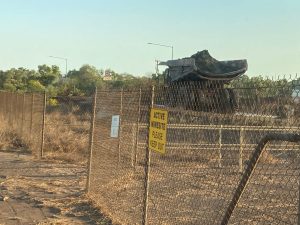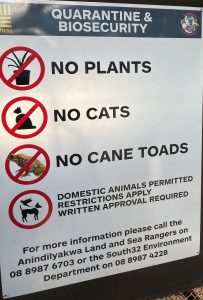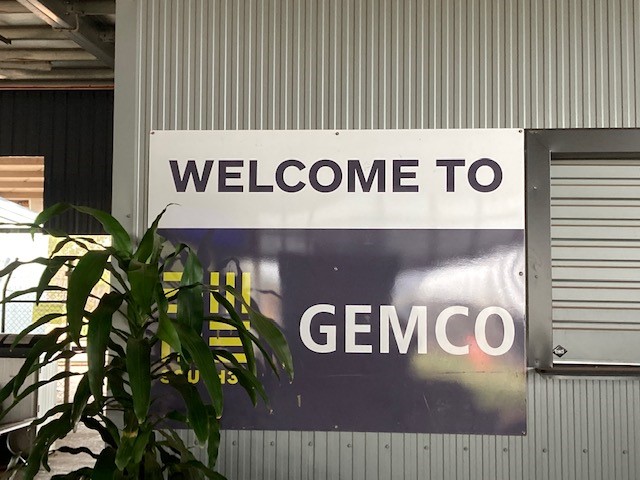I’d always wanted to go to Groote Eyland. It is officially part of Arnhem Land and is home to around 1600 indigenous Anindilyakwa people and what seems like a million mine-workers.


The flight from Darwin was only an hour due to a neat tail wind. The terminal is larger than ours on Flinders Island primarily because Groote Eylandt’s main economic activity is mining the manganese that forms a crust over most of the island. The mine requires lots of workers and contractors who fly-in and fly-out (known, rather unpoetically, as FIFOs). But there were some similarities to home, a baggage claim wagon was one of them (not a conveyor belt in sight).


You’re not out of the airport two minutes when the mine is in your face (right). Mining for manganese began more than fifty years ago here.
Left is a map of the main town called Alyangula. This is Gemco (Groote Eylandt Mining Company) headquarters and where more than 500 workers live, eat, sleep and socialise (and there are more accommodation areas elsewhere). There’s an RSL-style social club (where I watched the NRL GF), a swimming pool, gym, squash, tennis and basketball courts, body-sized punching bags and more to keep the FIFOs fit and happy. The facilities in this town are much more extensive than either of the two local communities we drove through. But then, the members of the fourteen clans that make up the Anindilyakwa people probably don’t feel the need to smack a ball over a net in 36 degree heat.

And I’d reckon the locals are amused, too, that whitefellas would chase a little white ball over grass areas that requires these warnings (this one is on the golf club’s fence) but the view, as for our golf course on Flinders, is pretty nice.


This warning was more to my liking (though the only quoll I saw was, sadly, roadkill).
Some other warnings you see around the island:



As we were coming in to land, we were asked to check our luggage for cane toads. I wondered if the island got a lot of stowaways. Presumably they do because someone has invested in this signage.
And if the toads can’t read or won’t heed the warnings, visitors and residents are asked to intervene. Some signs telling me how to catch a cane toad might have been useful. Thankfully I didn’t come across any errant amphibians.
The two-weeks-on/one-week-off life of a mine worker is hard to avoid in Alyangula (not to mention repetitive). The mess (aka Groote Eylandt Dining Room) can feed 600 in a sitting.

Mine vehicles are everywhere: on roads, in driveways and car parks. They have every piece of safety gear you can think of from flashing lights to a whistle to attract attention (obviously I’ve listened to way too many safety briefings). They also are GPS-tracked. When I went out with a mate who works as a FIFO contractor, he asked one of his colleagues to drive us to and then pick us up from the social club because if the car is logged at the licensed venue too long, it can be a sack-able offence.
(for Flinders readers: the mate was Chad Jackson, Anna Luddington’s husband).

My bungalow had a picture-perfect tropical islands view until this freighter steamed past. Container ships just don’t go with palm trees and turquoise.
But enough of mines. If you look closely enough, there are non-mining attractions on Groote, they’re just not immediately apparent. This rock art site is stupendous (and yes, I did check about posting images of the rock art). It is the only one visitors are welcome to view and is a few kms down a 4WD track.
Groote Eylandt — named by Abel Tasman — means Great Island as, indeed, Flinders Island was once named. Groote can also mean ‘big’ and it is Australia’s fourth largest (Flinders, in case you are wondering, comes in seventh). It has been inhabited for at least 8,000 years.

There are lovely beaches of course (but you can’t swim at them because of the crocs). Two Anindilyakwa women were sitting under one of these shelters dying silk scarves.
Houses in the two communities are simple (below left) and very different to the mining houses (centre). The locals houses might be simple but the communities have done a lovely job of decorating this school and this grave. Speaking of graves, the pic bottom right shows the areas/roads on the island that are open and closed. Areas and/or roads are closed as a mark of respect when a community member passes away. One time (before my guide lived on the island so I don’t have more details yet) an especially important elder or TO (Traditional Owner) died and the entire mining operation shut down for two days (I’m guessing he or she was on the board of the Land Council or otherwise involved with the mine).

And, back in Alyangula, just in case the visitor has been overwhelmed by art and nature, and has forgotten the mine, the company has placed a monument to manganese in the centre of town. The mining lease was recently renewed by the Anindilyakwa Land Council for a further ten years and although it could well be renewed after that if they find more manganese deposits, attention is starting to focus on a post-mining era for the island.

Groote Eylandt Lodge used to be owned and operated by a for-profit arm of the Land Council but was apparently sold to GEMCO recently. It has 74 rooms, a bar and restaurant and this rather nice pool that I spent a bit of time in. It also has a Cultural Centre (really a shop, but with very nice indigenous art and craft).
Unless you have an ‘in’ with the locals, a few days is enough to fit in most tourist activities and still leave you plenty of time for the pool and Groote’s rather lovely sunsets.




I was going to leave you with pretty sunsets but noticed this sign to welcome disembarking passengers as I waited for the plane. There’s not one that says ‘Welcome to Groote Eylandt’ that I could see.















